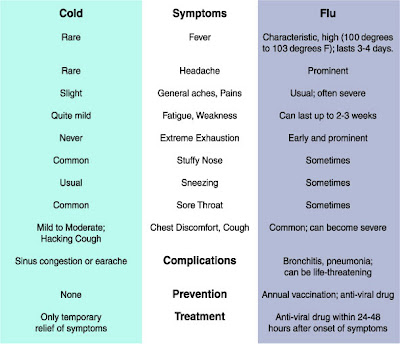Influenza, or flu, is a respiratory infection caused by a variety of flu viruses. The most familiar aspect of the flu is the way it can iknock you off your feeti as it sweeps through entire communities.
The flu differs in several ways from the common cold, a respiratory infection also caused by viruses. For example, people with colds rarely get fevers or headaches or suffer from the extreme exhaustion that flu viruses cause.
Anyone can get the flu; however, the largest infection risks are in highly populated areas, like schools.
The incidence of flu within schools is greatest among children, ages 5- to 14- years, with bacterial pneumonia being the most common complication.
People most susceptible to flu complications are older adults, those with chronic medical conditions like asthma, and children younger than age two.
 The U.S. Centers for Disease Control and Prevention (CDC) estimates that 10 to 20 percent of Americans come down with the flu during each flu season, which typically lasts from November to March. Children are two to three times more likely than adults to get sick with the flu, and children frequently spread the virus to others. Although most people recover from the illness, CDC estimates that in the United States more than 100,000 people are hospitalized and about 36,000 people die from the flu and its complications every year.
The U.S. Centers for Disease Control and Prevention (CDC) estimates that 10 to 20 percent of Americans come down with the flu during each flu season, which typically lasts from November to March. Children are two to three times more likely than adults to get sick with the flu, and children frequently spread the virus to others. Although most people recover from the illness, CDC estimates that in the United States more than 100,000 people are hospitalized and about 36,000 people die from the flu and its complications every year.
Is it a Cold or Is it the Flu ?
The flu differs in several ways from the common cold, a respiratory infection also caused by viruses. For example, people with colds rarely get fevers or headaches or suffer from the extreme exhaustion that flu viruses cause.
Anyone can get the flu; however, the largest infection risks are in highly populated areas, like schools.
The incidence of flu within schools is greatest among children, ages 5- to 14- years, with bacterial pneumonia being the most common complication.
People most susceptible to flu complications are older adults, those with chronic medical conditions like asthma, and children younger than age two.
 The U.S. Centers for Disease Control and Prevention (CDC) estimates that 10 to 20 percent of Americans come down with the flu during each flu season, which typically lasts from November to March. Children are two to three times more likely than adults to get sick with the flu, and children frequently spread the virus to others. Although most people recover from the illness, CDC estimates that in the United States more than 100,000 people are hospitalized and about 36,000 people die from the flu and its complications every year.
The U.S. Centers for Disease Control and Prevention (CDC) estimates that 10 to 20 percent of Americans come down with the flu during each flu season, which typically lasts from November to March. Children are two to three times more likely than adults to get sick with the flu, and children frequently spread the virus to others. Although most people recover from the illness, CDC estimates that in the United States more than 100,000 people are hospitalized and about 36,000 people die from the flu and its complications every year.Is it a Cold or Is it the Flu ?



No comments:
Post a Comment